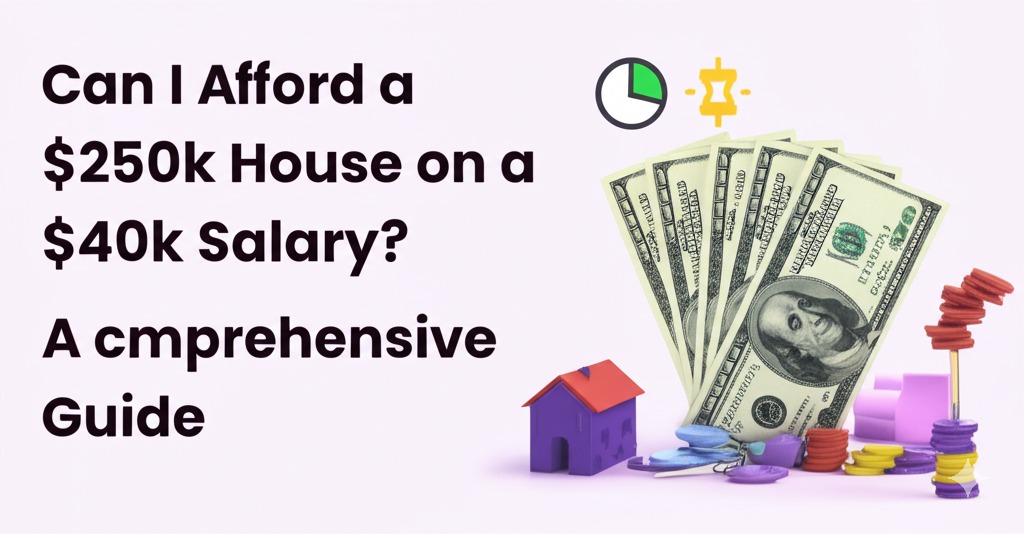
Buying a house is one of the most significant financial decisions you’ll ever make. It involves careful consideration of many factors, including your income, expenses, and long-term goals. If you’re asking, “Can I afford a $250k house on a $40k salary?” you’re not alone. Many people wonder if their salary is enough to purchase a home in today’s market. In this article, we’ll break down the key factors that determine whether a $40,000 income can comfortably support a $250,000 mortgage.
Understanding the Basics: What Does Affordability Mean?
Before diving into the specifics, it’s essential to understand what affordability means in the context of buying a home. Affordability is not just about the monthly mortgage payment; it also includes other homeownership costs like property taxes, insurance, maintenance, and utilities. The general rule of thumb is that your monthly mortgage payment should not exceed 28% to 30% of your gross monthly income.
With a salary of $40,000 per year, this means your monthly housing expenses should ideally be no more than $1,100 to $1,200. But can a $250,000 home fit within these limits?
Breaking Down the Numbers: Can a $250k House Fit Your Budget?
Mortgage Payment
The most significant part of your housing expenses will likely be your mortgage payment. If you’re purchasing a $250,000 home with a standard 20% down payment ($50,000), your loan amount would be $200,000. Assuming a 30-year fixed mortgage with an interest rate of around 6% (rates fluctuate), your monthly mortgage payment would be approximately $1,200.
Additional Homeownership Costs
In addition to the mortgage, there are several other costs that come with owning a home:
- Property Taxes: These can vary depending on where you live but are often 1% to 2% of the home’s value per year. For a $250,000 home, this could range from $2,500 to $5,000 per year or about $200 to $400 per month.
- Homeowners Insurance: Typically around $1,000 to $1,500 per year, or $80 to $125 per month.
- Maintenance and Repairs: It’s recommended to budget 1% of your home’s value each year for upkeep. For a $250,000 house, that’s $2,500 per year or $200 per month.
When adding these costs together, your total monthly homeownership expenses would look something like this:
- Mortgage Payment: $1,200
- Property Taxes: $300
- Homeowners Insurance: $100
- Maintenance and Repairs: $200
This brings your total to about $1,800 per month—a bit higher than the ideal 28% to 30% range of your income. But is it still manageable?
Evaluating Your Financial Situation: Can You Afford $1,800 per Month?
To determine whether $1,800 per month is manageable, let’s assess your overall financial picture.
Other Monthly Expenses
Before committing to a mortgage, it’s essential to consider other essential expenses, such as:
- Student loans (if applicable)
- Car payments
- Health insurance
- Utilities and groceries
- Credit card payments and debt
You want to ensure that after accounting for your mortgage, utilities, and other necessary expenses, you still have room to save and cover emergencies. If your monthly expenses total $3,000 and you make $40,000 per year (which works out to about $3,333 per month after taxes), a $1,800 mortgage could leave you with very little flexibility.
Debt-to-Income Ratio (DTI)
Lenders often use the debt-to-income ratio (DTI) to assess whether you can afford a loan. Your DTI ratio is calculated by dividing your total monthly debt payments by your gross monthly income. Ideally, your DTI should be under 36%, though some lenders may allow up to 43%.
If your salary is $40,000 per year ($3,333/month), and you have $1,800 in housing expenses, that already puts you close to a 54% DTI—a number that could raise red flags with most lenders.
Can You Still Make It Work?
While it may be difficult to afford a $250,000 home on a $40k salary, there are ways to make it more feasible:
- Increase Your Down Payment: If you can afford a larger down payment, it will lower your loan amount, which in turn reduces your monthly mortgage payment.
- Look for Cheaper Homes: Consider homes priced below $250,000 or in areas with lower property taxes.
- Shop for Better Loan Terms: A lower interest rate or a longer loan term could help reduce your monthly payments.
- Cut Other Expenses: Look for ways to reduce non-essential spending, freeing up more money for your mortgage.
Alternative Financing Options
If you’re struggling to make a $250,000 home work on a $40,000 salary, there are a few financing options to explore:
- FHA Loans: These loans are backed by the Federal Housing Administration and often allow for lower down payments and more lenient credit score requirements.
- VA Loans: If you’re a veteran, you may be eligible for a VA loan, which often requires no down payment and offers favorable terms.
- USDA Loans: For those looking to buy in rural areas, USDA loans may provide low or no down payment options.
Conclusion: Is It Possible to Afford a $250k House on a $40k Salary?
While buying a $250,000 home on a $40,000 salary is possible, it requires careful financial planning and consideration. It’s crucial to account for all costs associated with homeownership, including the mortgage, property taxes, insurance, and maintenance. Be mindful of your debt-to-income ratio and make sure you have enough room in your budget for other necessary expenses.
If you’re unsure whether homeownership is right for you at this price point, it may be helpful to consult with a financial advisor or mortgage lender who can help guide you through the process.

Andre Cuevas provides career insights, job search strategies, and professional advice to help individuals navigate the job market and achieve their career goals.






